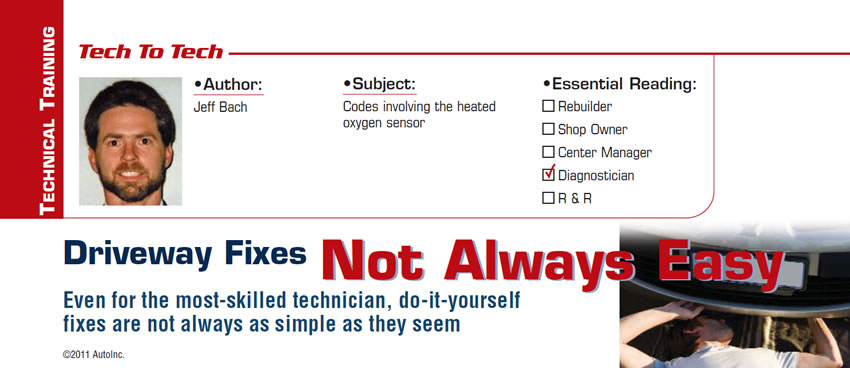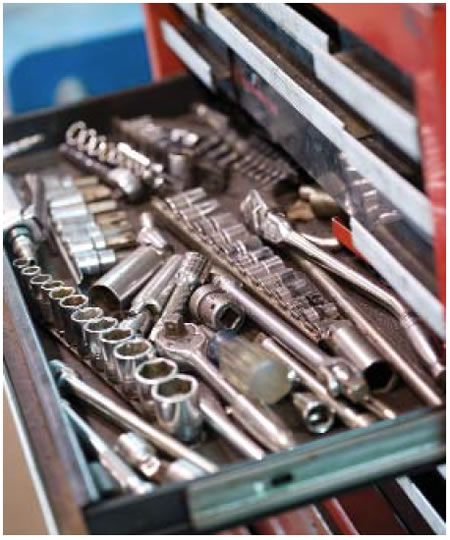
Tech to Tech
- Subject: Codes involving the heated oxygen sensor
- Essential Reading: Diagnostician
- Author: Jeff Bach
Even for the most-skilled technician, do-it-yourself fixes are not always as simple as they seem
In this day and age of technology, most of the problems motorists encounter can be found on a “fix database” somewhere. The more everyone relies on these fixes, however, the less we technicians are needed to troubleshoot problems. Technicians are not the only ones looking for fixes on the Internet. “Do-it-yourselfers,” as well as many car owners who are caught in the current economic crunch, are finding their own solutions on the Internet with simple Google searches.
The fixes that aren’t found for free with a search engine can be had for a fee at several of the popular “find-a-fix” websites. Fortunately, though, there is a bright side to the pervasive parade of technological advances. Manufacturers’ engineers – in an effort to comply with the EPA’s constantly tightening OBD-II mandates – have inadvertently made the sometimes-simple problem seem technologically too difficult for the average do-it-yourselfer to solve.
Take, for example, any code that uses heated oxygen sensor (HO2S) in its description to point to a problem with long-term fuel trim (LTFT) reaching its upper or lower limit.
Many times, a potential customer will get a “Fix my malfunction indicator lamp” (MIL) request near the top of his weekend “Honey Do” list. Off he goes early in the morning to the local parts chain store – after picking up his favorite “watch the game with” beverage – to get his codes read for free (which most of the parts chains will do). If he gets a couple of the more-common codes – say, in the P0171 through P0175 range – likely as not he’ll go home with a cleared computer and a new HO2 sensor. The store guys know that once the computer is cleared it may be days or even weeks before the monitors will pick up on the malfunction, depending on a multitude of factors. By then any number of other things can turn the light back on.
The car is parked in the driveway. He takes a cursory glance under the hood and the underside of his spouse’s SUV. The culprit is quickly spotted, screwed into the exhaust pipe. Looks easy enough, he thinks to himself. He gets his crescent wrench and manages to break the sensor loose from the pipe. A little more difficulty is encountered getting the plug end loose. He gets the O2 sensor screwed in tight and didn’t even spill anything. It’s then that he realizes that the plug is different. This is upsetting.

A beverage or two later, out comes the plug. He screws the old sensor in finger tight just to plug the hole in the exhaust so as not to attract any unneeded attention. No need to plug it in since it’s shot anyway. Off he goes back to the parts store with a new attitude, and guess what. The MIL is back on before he gets out of the driveway. It seems that the comprehensive component monitor has done an excellent job of spotting the open in HO2S circuit for B1S2 suspending some of the other monitoring.
Standing in line now at the parts store with gears turning, foot tapping and eyeballs rolling over the “No returns on electrical parts” sign, he hears “Next” and walks down the counter to the open cubicle. He goes into the “But you guys gave me the wrong part” speech he had rehearsed in his mind while waiting in line, and the counter guy grabs the “code checker.” Sure enough, he has a hard code for B1S2 O2-sensor heater circuit. Grinning like the “Grinch,” he leaves with another O2 sensor; this one was even a little cheaper.
Back in the driveway now with the door of the vehicle open so he can hear the game playing on the SUV’s radio, he gets the new O2 sensor in and plugged up. His wife meets him at the door with some dish soap and a bucket of water so he doesn’t track up the kitchen floor and grease up her sink again. He dries his hands on the worn college sweatshirt he put on to listen to the game in and gets in the car to test-drive it. He turns the key over and the starter just clicks. He would turn the key off and let it sit a minute, but he doesn’t want to miss any of “The Game.” The battery is still strong enough to play the radio after all. With his work car now pulled up beside his wife’s SUV, he gets her jumper cables out of her emergency kit. With both hoods lifted, he starts his car for extra power and makes the connections.
He gets a good spark from her battery as he tests for good connection with the cable end when he makes the last contact. He gets in the SUV and gives the key a turn. The engine cranks over and over nicely but refuses to start. He tries a few more times, each time cranking until the battery is too weak to crank. Frustrated, he now gets more refreshment. Finally, he delivers the bad news to his wife that the parts store gave him another bad sensor and now her car won’t even start.

A meeting of the minds occurs and it’s decided that she would better be able to convince the parts-store guys to give her another new sensor while he stays home and goes to item No. 2 on his list: Clean leaves out of the gutter.
Skip ahead to the phone call with the results of our testing. “Wait a minute; explain it to my husband; he’s the smart one when it comes to cars,” the spouse says.
Parts store: “What we found is that you need a new battery because yours is not passing a load test. You need an oil change because there is too much fuel in it from possibly cranking the car too many times with fouled plugs. The plugs need to be changed. Your electronic control unit (ECU) needs to be replaced, and we have to reprogram the new one to your vehicle identification number (VIN). The ECU is the reason why the car is not starting. Once we get the car to run, there may be additional problems that we can’t determine until we get that far.”
The “OK” was given after some discussion with the family’s chairman of the board.
The next conversation I had gave me the feeling of skating on thin ice. I was thinking, “Here it comes; now what?”
Shop: “Well, after driving it until the system monitors ran, I discovered that your mass-air-flow (MAF) sensor is putting out a skewed signal causing some lean O2 codes. Now, we may be able to clean the mass-air-flow sensor and fix that problem, but I can’t guarantee that it will work. There is also a code for the Bank 1 sensor, which I can see is a new sensor – but we haven’t had much luck replacing them on this vehicle with anything but a dealer sensor that costs quite a bit more than the one that’s in it. Can you get your money back from the parts store where you got that one?”
Wrong question! Which brings us to the real question: Which is worse – a DUI or a dislocated shoulder?

Jeff Bach is the owner of CRT Auto Electronics, an ASA-member shop in Batavia, Ohio. For more information on this topic, contact Bach at 515-732-3965. His e-mail address is [email protected] and his Web site is www.currentprobe.com.
This copyrighted article is reprinted with the permission of AutoInc., the official publication of the Automotive Service Association (ASA). To learn more about ASA and its commitment to independent automotive-service and repair professionals, visit www.ASAshop.org or call 800-272-7467.













